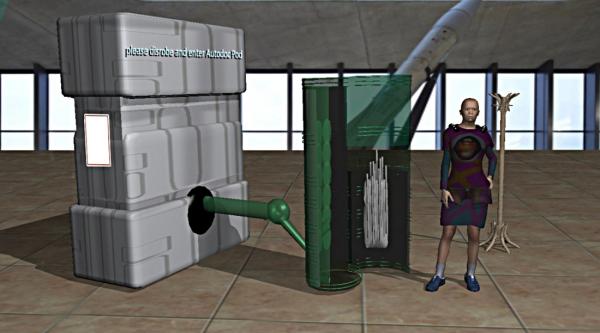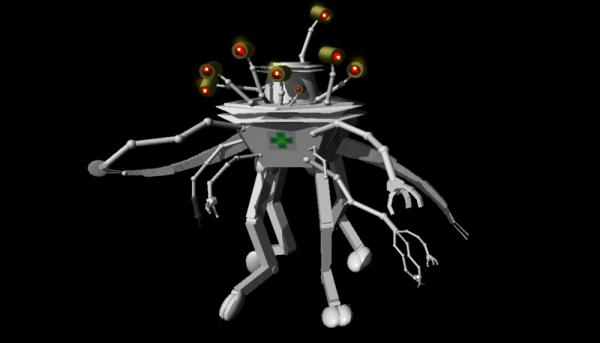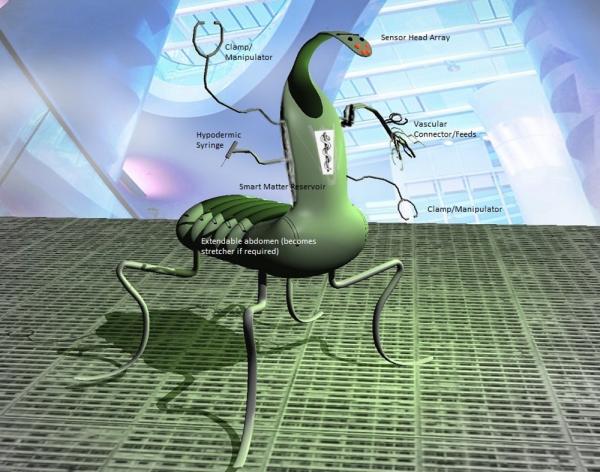BY LETTER
Autonomous Doctors
Technology > Technology Levels > High Tech / Hitech
Technology > Application > Medical Treatment
Technology > Application > Robotics
Technology > Application > Medical Treatment
Technology > Application > Robotics
Autodocs; including docbots and docboxes | |
 Image from Steve Bowers | |
| A Docbox in open position | |
Also known as healers, robo-doctors, exodocs (with many more names varying by culture). Autonomous Doctors (autodocs) are a class of bot designed for medical intervention and treatment independent of sophont instruction. Sophont robots built for the same purpose are distinct and usually are referred to as medivecs though sometimes they are categorised along with bionts as simply doctors. The relationship between autodocs and doctors varies across cultures. In some societies a doctor acts as a biomedical researcher, designing new treatments that autodocs can then carry out. In others doctors act as fashion gurus for cosmetic alterations and augmentations and utilise autodocs to design and apply appropriate procedures. In other's still both of these are the job of a doctor.
From the Early Information Age robots were used in medicine for a variety of tasks including delicate surgery; by the Middle Information Age teleoperated surgeries conducted/aided by specialist doctors were common for some procedures. As AI technology developed robots could perform more tasks autonomously; this led to an increasing number of surgical procedures involving semi-autonomous robots that only required human doctors for guidance and advice (who in some cases could work from afar across the Net).
By the end of the Information Age AI and robotic development allowed for totally unsupervised surgeries; the first of which was an appendectomy performed in record time by a collection of machines that could administer anaesthesia as necessary, remove the appendix and deal with all common complications. From then onwards autonomous robots in medicine have been improved upon continually leading to the creation of the autodocs class. Distinct from early specialised medical robots autodocs are generalist bots that have expert knowledge in thousands of areas of medicine and have the hardware necessary to treat almost any condition (in a sophont of almost any clade) from simple infection diagnosis/treatment to near-total body reconstruction from mass trauma. The increasing sophistication and deployment of autodocs along with nanomedical system adoption (see below) saw the decline in the traditional, ancient practice of buildings purpose built for medical care. By the middle Interstellar Age these "hospitals" and "doctors surgeries" were replaced in most cultures by distributed docbot stations equipped with a few docboxes for extreme cases.
In addition to performing medical procedures autodocs can be very handy for cosmetic alterations and augmentations. Common examples include a simple course of genestick injections, infusion of programed medibots, insertion of a tissue scaffold and (in the case of implantable augmentations) installation of implants/prosthetics. Regarding the latter example in many circumstances the augmentation in question must be manufactured elsewhere rather than by the autodoc.
Over the Interstellar Age autodocs became a prominent and vital component of healthcare infrastructure in the civilised regions of the galaxy. However they proceeded to become less relevant with the development of genemods, biotech augments and nanomedical systems. Around the time of the formation of the Sephirotic Empires it was rare for a sophont to ever experience an injury that they could not completely heal from in time. Since then in the civilised galaxy autodocs exist either to speed repair/cosmetic alteration or deal with serious traumas and infection that may be encountered (the former through choice/low angelnetting, the latter through both these plus evolution of nanomedical resistant nano/bio/syn-organism). In less sophisticated societies or regions where local laws/culture proscribe against personal modification autodocs are more common.
Generally autodocs come in two forms: mobile docbots or immobile docboxes.
 Image from Steve Bowers | |
| A docbot from the Late First Federation era | |
Docbots
Coming in all shapes and sizes a docbot is a bot possessing some means of locomotion as well as a suite of hardware allowing almost any condition to be treated. An example of a generic docbot design consists of an ovoid body ~1m long by 0.5m wide (at widest point) with 4-8 slender, totally articulated legs. The surface of the body is covered in sensors and scanners for highly detailed perception of the environment (important for locating injured sophonts in inaccessible/hidden locations) as well as probes for patient diagnosis. The inside of the body holds a host of medical hardware designed for multiple functions and for modification on demand so as to grant the most diversity of use possible. As required these medical devices can protrude through the body on articulated limbs for use. Image from Steve Bowers | |
| A Docbot in the Current Era | |
Typical docbot hardware consists of a variety of manipulators, smart spray-bandages for both sealing/healing lacerations (through the release of appropriate healing factors and regenerative scaffolds), genesticks, syringes/infusers (supplied by internal medicine/medibot caches/synthesises), cutting tools, electric/thermal/acoustic stimulators, polymorphic scaffold prosthetics (emulates tissue function whilst stimulating in situ tissue regeneration), bioforge for synthesising transplant tissue/transfusion fluids, mindstate uploaders (both destructive and non), pop-up hermetically sealed tents and trolley cots. Some models of docbot also include knowledge and tools for psychological care (beyond psychosurgical and psychoactive treatment of mental illness, shock etc) allowing them to act as counsellors and psychiatrists though in many societies empais, empaths and cognitive therapy DNI software is more common.
In life threatening situations such as mass trauma or late stage infection a docbot can act as a life support machine by infiltrating a sophont's body with fractal tendrils that fuse with vital organs and systems (whilst continuing to treat). Mechanisms within the docbot can act as prosthetic organs to keep the body alive and the infiltrating tendrils can work to regenerate vital tissues in situ.
Whilst they are capable of treating all common conditions and most serious conditions docbot are limited in their capabilities by the amount of hardware they can carry. This is particularly a problem when a sophont is severely injured and the docbot lacks the required amount of biological material to synthesise new tissue and/or lacks the time in which to repair/synthesise enough tissue to stabilise the patient, even acting as life support. When confronted with such a situation a docbot switches its focus to keeping the patient alive until it can reach a more sophisticated immobile docbox or (where possible) to upload the patient's mindstate as they die. Alternatively if the user has a memory box a docbot can simply manage the sophont's pain or even euthanize the patient (if their wishes and local laws allow) before recovering the body, the head or just the memory box depending on the patient's wishes and environmental conditions. Indeed in some societies autodocs of all kinds weigh up the time and resources it would take to repair a body against synthesising a new one and simply euthanize the patient and retrieve their memory box/upload their mindstate if it is more convinient (though usually not if it is against the sophonts wishes).
In many cultures home/dormbots can arguably be classified as docbots or partial autodocs as it is common for them to contain deployable medical hardware (such as N-FAKs).
 Image from Steve Bowers | |
| Docbox rotating into horizontal position | |
Docboxes
Much larger than their mobile counterparts docboxes commonly resemble cuboid containers (though there are many other forms such as chairs, baths etc. available) with typical dimensions for a near-baseline model around 200cm x 125cm x 100cm: dimensions vary according to the clade it is designed for. The top of a docbox acts as a transparent lid that can either completely open or act as a semi-permeable membrane to maintain interior sterility. The lid can also act as a three-dimensional, holographic screen so as to display patient data, usually in the form of augmented reality (i.e. a patient lying in the docbox with a heart complaint will see their reflection modified with a transparent chest so as to see their heart and watch videos of the procedures that could be done). The base of the interior is a morphable surface that a patient lies on, the surface can change to be as comfortable as possible and can contort to manipulate the body into required positions and to expose body parts as necessary.The main components of a docboxes are similar to that of docbots. Encased in the walls and base of a docboxes are a wide range of diagnostic and medical equipment which can be extruded as necessary. However docboxes can contain a larger array of equipment allowing them to perform many different procedures at once (from diagnostic to surgical) and contain a greater number of artificial organs granting more effective life support. In addition the bioforges of a typical immobile are far bigger and more specialised allowing for rapid tissue synthesis for transplant.
The primary reason that docboxes are immobile (as opposed to simply large mobiles) is the presence of nutrient and power feeds. This in combination with the systems inherent within a docbox grants engenerator level capabilities, thanks to this they can synthesise an entire body when necessary (using the nutrient feed or recycling the patient's body).
Docboxes can use their engenerator capabilities to save a sophont from almost any life threatening condition including decapitation providing that the brain is placed in the docboxes before damage can occur and even with damage as long as a memory box is in place. Additionally it is very common for docboxes to be used as biomedical research equipment in the case of newly evolved pathogens. Even in advanced societies studying mutated nano/bio/syn-organisms is an important field for both preventing potential disease and possibly learning from nature. When a sophont catches a newly evolved pathogen they can be quarantined in a docbox for treatment and study. It is even quite common for sophonts to simply be uploaded out of their body and synthesised in a new one, donating their old to the pursuit of medical science.
 Image from Steve Bowers | |
| Docbox in active position | |
Because of this sophistication docboxes are capable of drastic body modification and body swapping; supplied with the relative materials a docboxes can easily switch a sophonts clade, even from biological to vec (this may require a mindstate upload).
Regarding Cyborgs and Vecs
In most societies cyborgs and vecs represent significant, if not the majority, segments of the demographic. Due to this comprehensive autofabs and a plethora of mechanical tools are included in autodoc designs so as to cater for these sophonts as well as bionts, bionoids, biobots and bioborgs. These models of autodoc are also capable of both synthesising and installing augmentation implants/prosthetics rather than having to have them fabricated elsewhere for installation.Related Articles
- Biomedical Engineering - Text by M. Alan Kazlev
The design and development of medical technology, especially medical nanotechnology. Includes design and development of customized medical nanobots, synthetic biomaterials, large, small, cellular, and subcellular-scale body imaging and sensors, bio- and cybernetic implants and augmentations. - Medicine - Text by M. Alan Kazlev from original write-up by Robert J. Hall
Treatment or prevention of diseases, injuries, and physical disorders in organic beings. Includes study of anatomy and physiology, diagnosis of the illness, use of medical bionano and hylonano, pharmaceuticals, invasive and non-invasive surgical techniques, holistic healing, xenomedicine, virtual medicine, and historical medicine. - Medicyte
- Nanomedicine
- Nanomedicine First Aid Kit (N-FAK)
- Personal Medical System - Capabilities
- Personal Medical Systems (Medisystems)
- Surgicon
Appears in Topics
Development Notes
Text by Ryan B
Initially published on 19 March 2013.
updated march 2017
Initially published on 19 March 2013.
updated march 2017






